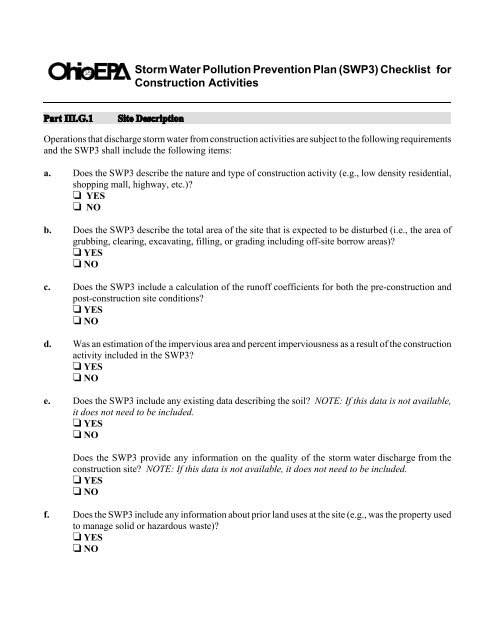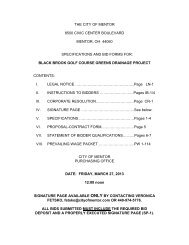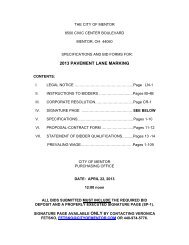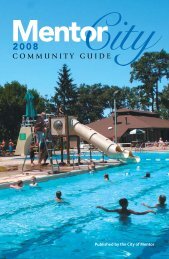Storm Water Pollution Prevention Plan (SWP3)
Storm Water Pollution Prevention Plan (SWP3)
Storm Water Pollution Prevention Plan (SWP3)
Create successful ePaper yourself
Turn your PDF publications into a flip-book with our unique Google optimized e-Paper software.
<strong>Storm</strong> <strong>Water</strong> <strong>Pollution</strong> <strong>Prevention</strong> <strong>Plan</strong> (<strong>SWP3</strong>) Checklist for<br />
Construction Activities<br />
Operations that discharge storm water from construction activities are subject to the following requirements<br />
and the <strong>SWP3</strong> shall include the following items:<br />
a. Does the <strong>SWP3</strong> describe the nature and type of construction activity (e.g., low density residential,<br />
shopping mall, highway, etc.)?<br />
‘ YES<br />
‘ NO<br />
b. Does the <strong>SWP3</strong> describe the total area of the site that is expected to be disturbed (i.e., the area of<br />
grubbing, clearing, excavating, filling, or grading including off-site borrow areas)?<br />
‘ YES<br />
‘ NO<br />
c. Does the <strong>SWP3</strong> include a calculation of the runoff coefficients for both the pre-construction and<br />
post-construction site conditions?<br />
‘ YES<br />
‘ NO<br />
d. Was an estimation of the impervious area and percent imperviousness as a result of the construction<br />
activity included in the <strong>SWP3</strong>?<br />
‘ YES<br />
‘ NO<br />
e. Does the <strong>SWP3</strong> include any existing data describing the soil? NOTE: If this data is not available,<br />
it does not need to be included.<br />
‘ YES<br />
‘ NO<br />
Does the <strong>SWP3</strong> provide any information on the quality of the storm water discharge from the<br />
construction site? NOTE: If this data is not available, it does not need to be included.<br />
‘ YES<br />
‘ NO<br />
f. Does the <strong>SWP3</strong> include any information about prior land uses at the site (e.g., was the property used<br />
to manage solid or hazardous waste)?<br />
‘ YES<br />
‘ NO
Construction Site <strong>SWP3</strong> Checklist<br />
Page 2 of 14<br />
g. Does the <strong>SWP3</strong> include an implementation schedule which describes the sequence of major<br />
construction operations (i.e., grubbing, excavating, grading, utilities and infrastructure installation)<br />
and the implementation of erosion, sediment and storm water management practices or facilities to<br />
be employed during each operation of the sequence?<br />
‘ YES<br />
‘ NO<br />
h. Does the <strong>SWP3</strong> include the name(s) or location(s) of the initial and subsequent surface water bodies<br />
receiving the storm water discharge?<br />
‘ YES<br />
‘ NO<br />
Does the <strong>SWP3</strong> include the areal extent and description of the wetland or other special aquatic sites<br />
which will be disturbed and/or will receive the storm water discharges?<br />
‘ YES<br />
‘ NO<br />
i. For construction sites with no centralized sediment controls (e.g., a sediment settling pond or inlet<br />
protection) which receives drainage from multiple lots, does the <strong>SWP3</strong> include a detail drawing of<br />
a typical individual lot with shown sediment and erosion controls)?<br />
‘ YES<br />
‘ NO<br />
j. Does the <strong>SWP3</strong> include the location and description of storm water discharges associated with<br />
dedicated asphalt and/or concrete batch plants covered by the NPDES construction storm water<br />
general permit?<br />
‘ YES<br />
‘ NO<br />
k. Does the <strong>SWP3</strong> include a copy of the NPDES construction storm water general permit?<br />
‘ YES<br />
‘ NO<br />
A detailed site map is required by the NPDES construction storm water general permit. The site map must<br />
include the following items:<br />
1. Does the site map describe the limits of earth-disturbing activity of the site including associated offsite<br />
borrow or spoil areas that are not addressed by a separate NOI and associated <strong>SWP3</strong>?<br />
‘ YES<br />
‘ NO
Construction Site <strong>SWP3</strong> Checklist<br />
Page 3 of 14<br />
2. Does the site map describe the soils types depicted for all areas of the site, including locations of<br />
unstable or highly erodible soils?<br />
‘ YES<br />
‘ NO<br />
3. Does the site map show existing and proposed contours to delineate drainage watersheds expected<br />
during and after major grading activities as well as the size of each drainage watershed, in acres?<br />
‘ YES<br />
‘ NO<br />
4. Does the site map show surface water locations including springs, wetlands, streams, lakes, water<br />
wells, etc., on or within 200 feet of the site, including the boundaries of wetlands or stream channels<br />
and first subsequent named receiving water(s) the permittee intends to fill or relocate for which the<br />
permittee is seeking approval from the Army Corps of Engineers and/or Ohio EPA?<br />
‘ YES<br />
‘ NO<br />
5. Does the site map include the location of existing and planned buildings, roads, parking<br />
facilities, and utilities?<br />
‘ YES<br />
‘ NO<br />
6. Does the site map include the location of all erosion and sediment control practices, including<br />
the location of areas likely to require temporary stabilization during the course of site<br />
development?<br />
‘ YES<br />
‘ NO<br />
7. Does the site map include the location of sediment and storm water management basins noting<br />
their sediment settling volume and contributing drainage area?<br />
‘ YES<br />
‘ NO<br />
8. Does the site map include the location of permanent storm water management practices to be<br />
used to control pollutants in storm water after construction operations have been completed?<br />
‘ YES<br />
‘ NO<br />
9. Does the site map include areas designated for the storage or disposal of solid, sanitary, and toxic<br />
wastes (including dumpster areas), areas designated for cement truck washout, and areas for<br />
vehicle fueling?<br />
‘ YES<br />
‘ NO
Construction Site <strong>SWP3</strong> Checklist<br />
Page 4 of 14<br />
10. Does the site map include the location of designated construction entrances where the vehicles<br />
will access the construction site?<br />
‘ YES<br />
‘ NO<br />
11. Does the site map include the location of any in-stream activities including stream crossings?<br />
‘ YES<br />
‘ NO<br />
Erosion Control<br />
a. Non-Structural Preservation Methods<br />
Î Has every effort been made to preserve the natural riparian setback adjacent to streams or<br />
other surface water bodies?<br />
‘ YES<br />
‘ NO<br />
Ï Have efforts been made to phase in construction activities in order to minimize the amount<br />
of land disturbance at one time?<br />
‘ YES<br />
‘ NO<br />
Ð Will any portions of the site be left undisturbed (e.g., tree preservation areas)?<br />
‘ YES<br />
‘ NO<br />
b. Structural Erosion Control<br />
â Does the <strong>SWP3</strong> describe the control practices used to restabilize areas after grubbing or<br />
construction?<br />
‘ YES<br />
‘ NO<br />
Ï Does the <strong>SWP3</strong> specify the types of stabilization measures to be employed for any time of<br />
the year?<br />
‘ YES<br />
‘ NO
Construction Site <strong>SWP3</strong> Checklist<br />
Page 5 of 14<br />
i. Temporary Stabilization<br />
For disturbed areas within 50 feet of a stream remaining dormant for over 21 days, will<br />
temporary erosion controls be applied within 2 days?<br />
‘ YES<br />
‘ NO<br />
For disturbed areas over 50 feet away from a stream remaining dormant for over 21 days,<br />
will temporary erosion controls be applied within 7 days?<br />
‘ YES<br />
‘ NO<br />
For disturbed areas that will be left idle over winter, will temporary erosion controls be<br />
applied prior to onset of winter weather?<br />
‘ YES<br />
‘ NO<br />
ii. Permanent Stabilization<br />
For disturbed areas within 50 feet of a stream at final grade, will permanent erosion controls<br />
be applied within 2 days of reaching final grade?<br />
‘ YES<br />
‘ NO<br />
For disturbed areas remaining dormant for over 1 year or at final grade, will permanent<br />
erosion controls be applied within 7 days?<br />
‘ YES<br />
‘ NO<br />
c. Runoff Control Practices<br />
â Does the <strong>SWP3</strong> incorporate measures to reduce flow rates (e.g., riprap, ditch check dams)?<br />
‘ YES<br />
‘ NO<br />
Ï Does the <strong>SWP3</strong> incorporate measures to divert concentrated flow (e.g., pipe slope drains)?<br />
‘ YES<br />
‘ NO<br />
d. Sediment Control Practices<br />
â Will sediment control devices be implemented for all areas remaining disturbed for over 14<br />
days?<br />
‘ YES<br />
‘ NO
Construction Site <strong>SWP3</strong> Checklist<br />
Page 6 of 14<br />
Ï Are detail drawings of the sediment controls to be used included in the <strong>SWP3</strong>?<br />
‘ YES<br />
‘ NO<br />
i. Timing<br />
Does the <strong>SWP3</strong> specify that sediment controls will be installed/implemented within 7 days<br />
of grubbing activities?<br />
‘ YES<br />
‘ NO<br />
Does the <strong>SWP3</strong> propose alternate sediment controls for the changing slopes and topography?<br />
‘ YES<br />
‘ NO<br />
ii. Sediment Settling Ponds<br />
Does the <strong>SWP3</strong> include the installation and use of a sediment settling pond? NOTE:<br />
Sediment settling ponds are required for all drainage areas of 10 or more acres of land<br />
disturbed at one time. Sediment settling ponds are also required when the design capacity<br />
of silt fence or inlet protection has been exceeded.<br />
‘ YES<br />
‘ NO<br />
For construction activities that require sediment settling pond(s), does the <strong>SWP3</strong> propose to<br />
implement alternative controls to sediment settling ponds? NOTE: Alternative controls<br />
must be equivalent in effectiveness to a sediment settling pond.<br />
‘ YES<br />
‘ NO<br />
Is the volume of the sediment settling pond sized to receive at least 67 cubic yards of storm<br />
water per acre of drainage area?<br />
‘ YES<br />
‘ NO<br />
Is the maximum depth of each sediment settling pond less than or equal to 5 feet?<br />
‘ YES<br />
‘ NO<br />
Is the length to width ratio of the sediment settling pond at least two units of length for every<br />
one unit of width (> 2:1 length to width)? NOTE: The greater the distance from the storm<br />
water inlet into the pond to the storm water outlet, the greater likelihood of sediment<br />
settlement. This prevents short-circuiting of the pond.<br />
‘ YES<br />
‘ NO
Construction Site <strong>SWP3</strong> Checklist<br />
Page 7 of 14<br />
Will the sediment settling pond be cleaned out when the silt occupies 40 percent of the pond<br />
depth (approximately one-half of the pond depth)?<br />
‘ YES<br />
‘ NO<br />
Is the sediment settling pond designed to consider public (i.e., child) safety where site<br />
limitation preclude a safe design?<br />
‘ YES<br />
‘ NO<br />
iii. Silt Fence & Other Diversions<br />
Will silt fence or other diversions be used to control sheet flow?<br />
‘ YES<br />
‘ NO<br />
Will silt fence be used in areas of steep slopes or concentrated flow? NOTE: Silt fence is not<br />
permitted to be used for controlling high velocity storm water flow (only sheet flow).<br />
‘ YES<br />
‘ NO<br />
Design Capacity of Silt Fence<br />
iv. Inlet Protection<br />
Maximum drainage area (in<br />
acres) to 100 linear feet of<br />
silt fence<br />
Range of slope for a particular<br />
drainage area (in percent)<br />
0.5 < 2%<br />
0.25 > 2% but < 20%<br />
0.125 > 20% but < 50%<br />
Will the field drain inlets and/or the street curb inlets drain into a sediment settling pond or<br />
directly to surface waters of the state? NOTE: Inlet protection is mandatory where sediment<br />
settling ponds will not be implemented.<br />
‘ YES<br />
‘ NO<br />
v. Stream Protection<br />
Does the <strong>SWP3</strong> propose to use any structural sediment controls in a stream? NOTE: Use of<br />
structural sediment controls in-stream is prohibited in accordance with Part III.G.2.d.v.<br />
‘ YES<br />
‘ NO
Construction Site <strong>SWP3</strong> Checklist<br />
Page 8 of 14<br />
For construction activities that are on the stream bank or will involve stream crossing, does<br />
the <strong>SWP3</strong> include measures to minimize the number of stream crossings and/or the width<br />
of disturbance? NOTE: If work along a stream bank is necessary, a non-erodible pad or<br />
non-erodible stream diversion dams (sand bags) must be installed. If stream crossings are<br />
necessary, a non-erodible stream crossing must be installed.<br />
‘ YES<br />
‘ NO<br />
Does the <strong>SWP3</strong> include the installation of a structural post-construction best management practice (BMP)<br />
to manage storm water runoff once construction activities have been completed?<br />
‘ YES<br />
‘ NO<br />
Has a long-term maintenance plan been developed or included in the <strong>SWP3</strong> for maintenance of the structural<br />
post-construction BMP? NOTE: The long-term maintenance plan must be developed and provided to the<br />
post-construction site operator, but does not need to be implemented as required by this permit. Local<br />
municipalities may require maintenance plan implementation.<br />
‘ YES<br />
‘ NO<br />
Is the construction activity a linear project (e.g., pipeline or utility line installation) that does not result in<br />
the installation of impervious surface? NOTE: Linear projects that don’t result in the installation of<br />
impervious surface do not need the installation of structural post-construction BMPs.<br />
‘ YES<br />
‘ NO<br />
Large Construction Activities (5 acres and up)<br />
Does the <strong>SWP3</strong> include a structural post-construction BMP with a specified volume and drain time?<br />
‘ YES<br />
‘ NO<br />
If so, was one of the two methods proposed in the NPDES construction storm water general permit (CGP)<br />
used to determine the water quality volume (WQ v) and drain time?<br />
‘ YES<br />
‘ NO<br />
If the formula described in the CGP was used to calculate the WQ v, were the correct values used for:<br />
(a) runoff coefficient (C)? ‘ YES ‘ NO<br />
(b) precipitation depth (P = 0.75-inches)? ‘ YES ‘ NO<br />
(c) and the drainage area (A) to the BMP? ‘ YES ‘ NO
Construction Site <strong>SWP3</strong> Checklist<br />
Page 9 of 14<br />
If the structural post-construction BMP will be used for sediment storage and/or has a reduced infiltration<br />
capacity, was the WQ v increased by an additional 20 percent (“fudge factor”)?<br />
‘ YES<br />
‘ NO<br />
Does the drain time in the <strong>SWP3</strong> for the proposed structural post-construction BMP match the drain time<br />
for the selected BMP in the table below?<br />
‘ YES<br />
‘ NO<br />
Target Draw Down (Drain) Times for<br />
Structural Post-Construction BMPs<br />
Best Management Practice Drain Time of WQv Infiltration 24 - 48 hours<br />
Vegetated Swale and Filter Strip 24 hours<br />
Extended Detention Basin (Dry Basins) 48 hours<br />
Retention Basins (Wet Basins)* 24 hours<br />
Constructed Wetlands (above permanent pool) 24 hours<br />
Media Filtration, Bioretention 40 hours<br />
* Provide both a permanent pool and an extended detention volume above the<br />
permanent pool, each sized at 0.75 * WQ v<br />
If the <strong>SWP3</strong> proposes to use an alternative BMP instead of one of the BMPs listed in the table above, is the<br />
alternative BMP equivalent in effectiveness to the BMPs listed above?<br />
‘ YES<br />
‘ NO<br />
Is there a pre-existing drainage basin or other BMP that will receive the storm water drainage from the<br />
construction site, is it sized appropriately to treat the WQ v?<br />
‘ YES<br />
‘ NO<br />
For redevelopment projects which disturb 5 or more acres of land, was one of the following options used<br />
to as a post-construction practice:<br />
(a) 20 % reduction in impervious area? ‘ YES ‘ NO<br />
(b) a BMP sized to treat 20% of the WQ v? ‘ YES ‘ NO<br />
(c) or a combination of (a) and (b) above? ‘ YES ‘ NO
Construction Site <strong>SWP3</strong> Checklist<br />
Page 10 of 14<br />
Small Construction Activities (1 to 5 acres)<br />
Does the <strong>SWP3</strong> include a structural post-construction BMP? NOTE: A structural post-construction BMP<br />
is required for small construction activities, but the design standards have not been specified in the CGP.<br />
‘ YES<br />
‘ NO<br />
i. If so, does the <strong>SWP3</strong> explain the technical basis used to select the BMPs chosen where flows exceed<br />
pre-development levels?<br />
‘ YES<br />
‘ NO<br />
ii. Does the <strong>SWP3</strong> include the installation of velocity dissipation devices at discharge locations and<br />
outfall channels?<br />
‘ YES<br />
‘ NO<br />
Handling of Toxic or Hazardous Materials<br />
1. Does the <strong>SWP3</strong> provide directions on how to dispose toxic or hazardous wastes properly?<br />
‘ YES<br />
‘ NO<br />
2. Does the <strong>SWP3</strong> provide areas for recycling of used or unused hazardous materials?<br />
‘ YES<br />
‘ NO<br />
NOTE: No toxic or hazardous wastes shall be disposed into storm drains, septic tanks, or by burying,<br />
burning, or mixing the wastes.<br />
Waste Disposal<br />
Will containers (e.g., dumpsters, drums) be available for disposal of debris, trash, hazardous or petroleum<br />
wastes?<br />
‘ YES<br />
‘ NO<br />
NOTE: All containers must be covered and leak-proof.
Construction Site <strong>SWP3</strong> Checklist<br />
Page 11 of 14<br />
Clean Hard Fill<br />
1. Are bricks, hardened concrete, and soil waste free from contamination which may leach constituents<br />
to waters of the state?<br />
‘ YES<br />
‘ NO<br />
2. If clean construction wastes will be disposed into the property, are there any local prohibitions from<br />
this type of disposal?<br />
‘ YES<br />
‘ NO<br />
Construction & Demolition Debris<br />
Does the <strong>SWP3</strong> state that all construction & demolition debris (C&DD) waste will be disposed of in an Ohio<br />
EPA approved C&DD landfill as required by Ohio Revised Code (ORC) 3714? NOTE: Construction debris<br />
may be disposed of on-site, but demolition debris must be disposed in an Ohio EPA approved landfill.<br />
‘ YES<br />
‘ NO<br />
NOTE: Materials which contain asbestos must comply with air pollution regulations (see Ohio<br />
Administrative Code (OAC) 3745-20).<br />
Construction Chemical Compounds<br />
1. Does the <strong>SWP3</strong> designate areas used for mixing or storage of compounds such as fertilizers, lime,<br />
asphalt, or concrete?<br />
‘ YES<br />
‘ NO<br />
2. If so, are these areas located away from watercourses, drainage ditches, field drains, or other storm<br />
water drainage areas?<br />
‘ YES<br />
‘ NO<br />
Equipment Fueling & Maintenance<br />
1. Does the <strong>SWP3</strong> designate areas used for fueling or performing vehicle maintenance?<br />
‘ YES<br />
‘ NO<br />
2. If so, are these areas located away from watercourses, drainage ditches, field drains, or other storm<br />
water drainage areas?<br />
‘ YES<br />
‘ NO
Construction Site <strong>SWP3</strong> Checklist<br />
Page 12 of 14<br />
3. Has a spill prevention control and countermeasures (SPCC) plan been developed? NOTE: A SPCC<br />
plan must be developed for sites with one above ground storage tank (AST) of 660 gallons or more,<br />
total above ground tank storage of 1330 gallons, or below ground storage of 42,000 gallons of fuel.<br />
‘ YES<br />
‘ NO<br />
Concrete Wash <strong>Water</strong>s<br />
1. Does the <strong>SWP3</strong> designate areas used for receiving concrete chute or other concrete wash waters?<br />
‘ YES<br />
‘ NO<br />
2. If so, are these areas located away from watercourses, drainage ditches, field drains, or other storm<br />
water drainage areas?<br />
‘ YES<br />
‘ NO<br />
Contaminated Soils<br />
Does the <strong>SWP3</strong> address proper handling and disposal of soils contaminated by petroleum or other chemical<br />
spills? NOTE: All contaminated soils must be treated and/or disposed in Ohio EPA approved solid waste<br />
management facilities or hazardous waste treatment, storage or disposal facilities (TSDFs).<br />
‘ YES<br />
‘ NO<br />
Spill Reporting Requirements<br />
1. Does the <strong>SWP3</strong> describe what to do in the event of a small release (less than 25 gallons) of<br />
petroleum waste? NOTE: Petroleum based and concrete curing compounds must have special<br />
handling procedures.<br />
‘ YES<br />
‘ NO<br />
2. Does the <strong>SWP3</strong> describe what to do in the event of a larger release (25 or more gallons) of<br />
petroleum waste? NOTE: You must contact, Ohio EPA (at 1-800-282-9378), the local fire<br />
department, and the local emergency planning committee (LEPC) within 30 minutes of a spill of 25<br />
or more gallons.<br />
‘ YES<br />
‘ NO<br />
Open Burning<br />
1. Is open burning performed in a restricted area (as defined in OAC 3745-19)? NOTE: Open burning<br />
is permitted in restricted areas for barbeques, heating, and certain occupational purposes.<br />
‘ YES<br />
‘ NO
Construction Site <strong>SWP3</strong> Checklist<br />
Page 13 of 14<br />
2. Is open burning performed in a non-restricted area, but within 1,000 feet of an inhabited building<br />
away from the property? NOTE: Open burning in an unrestricted area is limited to scrap lumber,<br />
wooden fence posts, agricultural, land-clearing, or landscape wastes.<br />
‘ YES<br />
‘ NO<br />
Dust Controls/Suppressants<br />
1. Are dust suppressants proposed to be used in the <strong>SWP3</strong>?<br />
‘ YES<br />
‘ NO<br />
2. If so, are the areas which the dust suppressant will be applied located near catch basins for storm<br />
sewers or other drainage ways?<br />
‘ YES<br />
‘ NO<br />
NOTE: Used oil may not be used as a dust suppressant.<br />
Air Permitting Requirements<br />
1. Have appropriate measures been taken to ensure that all air pollution permits have been obtained?<br />
NOTE: Air pollution permits may be required for activities including, but not limited to, mobile<br />
concrete batch plants, mobile asphalt plants, concrete crushers, and large generators.<br />
‘ YES<br />
‘ NO<br />
2. For restoration or demolition projects, will a notification be submitted to Ohio EPA, Division of Air<br />
<strong>Pollution</strong> Control to determine if asbestos corrective actions are required?<br />
‘ YES<br />
‘ NO<br />
Process Wastewater/Leachate Management<br />
Will all process wastewaters (e.g., equipment washing, leachate associated with on-site waste disposal, and<br />
concrete wash-outs) be collected and disposed of properly (e.g., to a publicly-owned treatment works)?<br />
NOTE: The NPDES construction storm water general permit only authorizes the discharge of storm water<br />
and certain uncontaminated non-storm waters. The discharge of non-storm waters to waters of the state<br />
may be in violation of local, state, and federal laws or regulations.<br />
‘ YES<br />
‘ NO
Construction Site <strong>SWP3</strong> Checklist<br />
Page 14 of 14<br />
Permit-to-Install (PTI) Requirements<br />
For construction activities involving the installation and/or replacement of a centralized sanitary system,<br />
(including sewer extensions) or a sewerage system (except those serving one, two, and three family<br />
dwellings) and potable water lines, was a PTI application submitted to Ohio EPA?<br />
‘ YES<br />
‘ NO<br />
NOTE: Coverage under the NPDES construction storm water general permit does not alone authorize the<br />
installation of such sanitary sewerage systems or potable water lines.<br />
-------------------------------------------------------------------------------------------------------------------------------<br />
Does the <strong>SWP3</strong> include measures for implementing good housekeeping practices?<br />
‘ YES<br />
‘ NO<br />
Does the <strong>SWP3</strong> promote the use of protected storage areas for industrial or construction materials to<br />
minimize exposure of such materials to storm water?<br />
‘ YES<br />
‘ NO
















